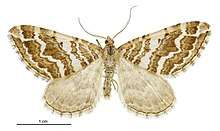Asaphodes declarata
| Asaphodes declarata | |
|---|---|
 | |
| Female | |
 | |
| Male | |
| Scientific classification | |
| Kingdom: | Animalia |
| Clade: | Euarthropoda |
| Class: | Insecta |
| Order: | Lepidoptera |
| Family: | Geometridae |
| Genus: | Asaphodes |
| Species: | A. declarata |
| Binomial name | |
| Asaphodes declarata | |
| Synonyms[2] | |
| |
Asaphodes declarata is a species of moth in the family Geometridae. This species is endemic to New Zealand.
Taxonomy
This species was described by Louis Beethoven Prout in 1914 as Xanthorhoe declarata using material collected by George Howes at Ben Lomond in Otago in February.[2][3] George Hudson discussed and illustrated this species under the name Xanthorhoe declarata in his 1928 publication The Butterflies and Moths of New Zealand.[4] However Hudson made an error, giving the incorrect name of the discoverer of the species, as well as the incorrect type locality.[2]
In 1987 Robin C. Craw proposed assigning this species to the genus Asaphodes.[5] In 1988 John S. Dugdale agreed with this proposal.[2] The holotype specimen is held at the Natural History Museum, London.[2]
Description
Prout described the species as follows:
♂︎. 36-38 mm. Very closely related to X. clarata Walk., but apparently quite distinct. Differs in the greyer brown (not ochreous) markings of the forewing and the white (not yellow or ochreous) hindwing. Forewing with the second subbasal white fascia less strongly curved ; discal dot enlarged, touching the first post-discal fuscous line ; outer boundary of median area less deeply inbent on fold ; white subterminal line less deeply dentate. The first fuscous post-discal line, though too variable in both species to give a constant distinction, is, as a rule, sharply out-angled between veins 6 and 7 in clarata, but in declarata only very obtusely bent or very gently curved. The hindwing beneath differs still more markedly : in clarata its basal half, though partly dark-marked, is encroached upon by a deep and large pale prong running inwards at vein 5 as far as the discocellulars (in some, measure even to the base) and another on the fold ; in declarata the basal half is much more uniformly dark-marked, its distal edge only forming two very moderate inward bends. Abdomen also whitish, dorsally with pairs of rather dark spots.[3]
Hudson noted that this species could easily be confused with a faded specimen of Asaphodes clarata. He also pointed out that A. declarata varies considerably in both size and, with the female of the species, in markings.[4]
Distribution
This species is endemic to New Zealand.[1][6] This species has been found in Otago and Southland.[4]
Biology and life cycle
Hudson stated that A. declarata can be found on the wing from November until February.[4] Adults have also been recorded in March.[7]
Habitat
A. declarata prefers open tussock habitat amongst beech forest in mountainous terrain.[4] It can be found at elevations of between 450 to 1750m in altitude.[4][7]
References
| Wikimedia Commons has media related to Asaphodes declarata. |
- 1 2 "Asaphodes declarata (Prout, 1914)". www.nzor.org.nz. Landcare Research New Zealand Ltd. Retrieved 21 August 2018.
- 1 2 3 4 5 Dugdale, J. S. (1988). "Lepidoptera - annotated catalogue, and keys to family-group taxa" (PDF). Fauna of New Zealand. 14: 173. Retrieved 21 August 2018.
- 1 2 Prout, Louis B. (1914). "New Lepidoptera (Geometridae)". Transactions and Proceedings of the New Zealand Institute. 46: 122–123 – via Biodiversity Heritage Library.
- 1 2 3 4 5 6 Hudson, G. V. (1928). The Butterflies and Moths of New Zealand. Wellington: Ferguson & Osborn Ltd. p. 119. OCLC 25449322.
- ↑ Craw, R. C. (2 February 2012). "Revision of the genus Helastia sensu stricto with description of a new genus (Lepidoptera: Geometridae: Larentiinae)". New Zealand Journal of Zoology. 14 (2): 269–293. doi:10.1080/03014223.1987.10422997. Retrieved 21 August 2018.
- ↑ Gordon, Dennis P., ed. (2010). New Zealand inventory of biodiversity. Volume two. Kingdom animalia : chaetognatha, ecdysozoa, ichnofossils. Vol. 2. Christchurch, N.Z.: Canterbury University Press. p. 459. ISBN 9781877257933. OCLC 973607714.
- 1 2 Patrick, Brian H.; Lyford, Brian M.; Ward, John B.; Barratt, Barbara I.P. (1992). "Lepidoptera and other insects of the Rastus Burn Basin, The Remarkables, Otago". Journal of the Royal Society of New Zealand. 22 (4): 265–278. doi:10.1080/03036758.1992.10420820. ISSN 0303-6758.